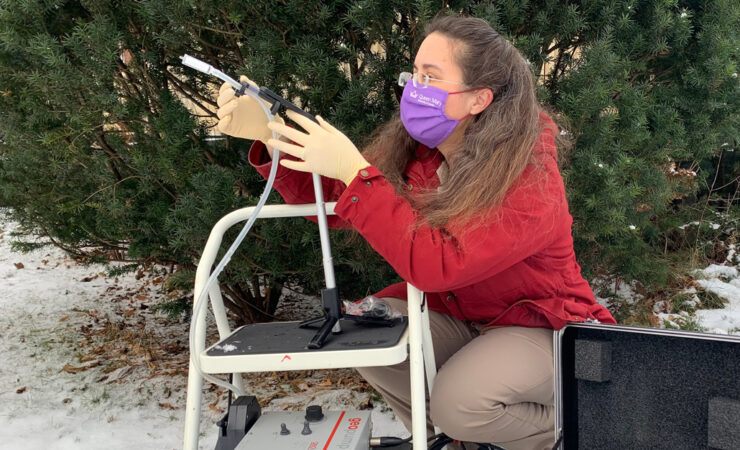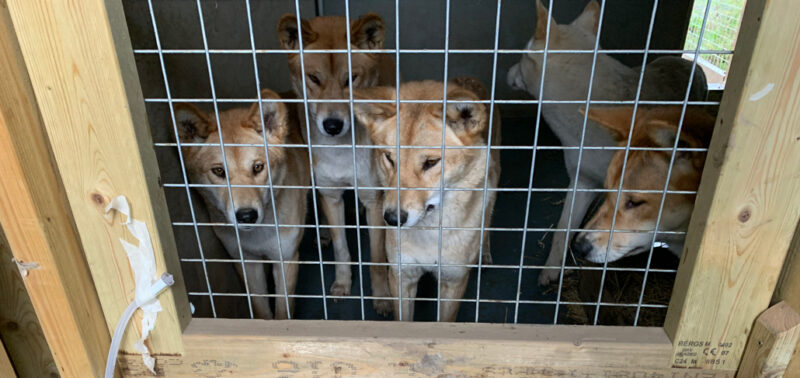On a dreary winter day in December of 2020, ecologist Elizabeth Clare strolled through the Hamerton Zoo Park in England wielding a small vacuum pump. She paused outside of animal enclosures, holding aloft a flexible tube attached to the machine. Her mission: suck animal DNA out of thin air.
The ability to sniff out animals’ airborne genetic material has been on scientists’ wish list for over a decade. DNA collected from water has been used to track aquatic species, including salmon and sharks (SN: 5/7/18). Scientists knew they could use environmental DNA, or eDNA, in the air to monitor land-based species — if only they could trap it. Now, researchers have done just that by using vacuums, two independent groups report January 6 in Current Biology.
“It’s such a crazy idea,” says Clare, of York University in Toronto. “We’re vacuuming DNA out of the sky.”
The idea came to Clare, who did the work while at Queen Mary University of London, during a previous experiment in which she sampled air outside naked mole rat burrows. At the zoo, Clare and colleagues ran the vacuum pump for half-hour sessions in and around animal enclosures, collecting 72 samples from 20 sites. Then, the team took the material ensnared in the pump’s filter back to the lab for analysis.
 Ecologist Elizabeth Clare samples air for animal DNA using a pump. When Clare and her colleague Kristine Bohmann discovered each other’s research, they decided to combine forces.E. Clare
Ecologist Elizabeth Clare samples air for animal DNA using a pump. When Clare and her colleague Kristine Bohmann discovered each other’s research, they decided to combine forces.E. Clare
Meanwhile, another team at the University of Copenhagen was unknowingly chasing the same idea. Biologist Kristine Bohmann and colleagues sought to trap airborne DNA at the Copenhagen Zoo using tiny fans similar to the ones that cool down computers. The team also experimented with a vacuum. Deploying their contraptions between 30 minutes and 30 hours at the tropical house, stables and in open air, the researchers found that both the fan and vacuum method collected ample animal DNA.
“It was so much fun,” Bohmann says. “It felt like we could just play around and be creative.”
To test the technique, both teams used a zoo for its roster of animals. Air in the wild could host DNA from unpredictable places, but at zoos, the researchers could cross-reference the captured airborne DNA with animals listed in exhibits. That allowed the scientists to confirm the source of the DNA, and see how far it traveled between enclosures.

Sign Up For the Latest from Science News
Headlines and summaries of the latest Science News articles, delivered to your inbox
Client key* E-mail Address* Go
Thank you for signing up!
There was a problem signing you up.
Bohmann and colleagues identified 49 different vertebrate species in the Copenhagen Zoo. They detected animals living in the sampled enclosures, such as okapis (Okapia johnstoni) in the stables and a Dumeril’s ground boa (Acrantophis dumerili) in the rainforest house. But the researchers also picked up on mammals and birds from surrounding exhibits as well as fish used as food. “That was quite surprising,” Bohmann says.
At the Hamerton zoo, Clare’s team identified 25 different species, including not only targeted zoo residents, but also unexpected ones. In the dingo enclosure, the team detected DNA from meerkats (Suricata suricatta) that live 245 meters away.
 Dingoes at the Hamerton Zoo Park in England inspect ecologist Elizabeth Clare’s vacuum device. Air samples from the zoo’s dingo enclosure contained DNA from dingoes and, surprisingly, meerkats, which live 245 meters away.E. Clare
Dingoes at the Hamerton Zoo Park in England inspect ecologist Elizabeth Clare’s vacuum device. Air samples from the zoo’s dingo enclosure contained DNA from dingoes and, surprisingly, meerkats, which live 245 meters away.E. Clare
Zoo outsiders also turned up in each team’s results. Clare’s team detected the European hedgehog (Erinaceus europaeus), which is endangered in England, while Bohmann’s group picked up on mice and domesticated dogs. They caught whiffs of human DNA too.
Sucking DNA from the air could be a noninvasive way to identify where endangered species have been by picking up on their genetic footprints, Bohmann says. The method would be an upgrade from camera traps, which work only when critters wander by, she says.
Neither team knew the other was working on the same concept. They got in touch after seeing an early version of each other’s studies on a preprint server. Clare describes it as “the most enormous scientific coincidence” of either of their lives. The teams chose to publish their studies together to corroborate each other’s results and further the adoption of their emerging ideas.
Just how this proof-of-concept technology will translate in the field is unclear. Airborne eDNA in the wild is more dispersed, and detection may be impacted by environmental factors such as weather and wind. But just as aquatic eDNA has progressed over the last decade, so too will airborne eDNA, Clare says. “I’m really looking forward to seeing other people go out and use the technique.”

